Equine anatomy
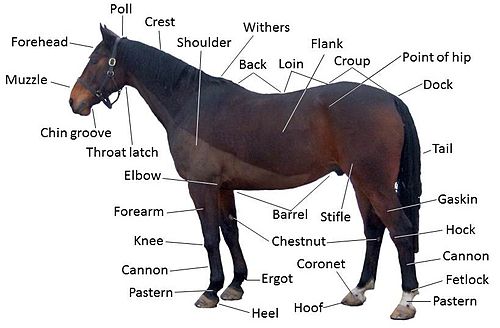
Equine anatomy encompasses the
External anatomy
- Back: the area where the saddle sits, beginning at the end of the withers, extending to the last thoracic vertebrae (colloquially includes the loin or "coupling", though technically incorrect usage)
- Barrel: the body of the horse,[1][2] enclosing the rib cage and the major internal organs
- Buttock: the part of the hindquarters behind the thighs and below the root of the tail
- Cannon or cannon bone: the area between the knee or hock and the fetlock joint, sometimes called the "shin" of the horse, though technically it is the third metacarpal
- Chestnut: a callosity on the inside of each leg
- Chin groove: the part of the horse's head behind the lower lip and chin, the area that dips down slightly on the lower jaw; area where the curb chain of certain bits is fastened
- Coupling: see "Loin" below
- Coronet or coronary band: the ring of soft tissue just above the horny hoof that blends into the skin of the leg
- Crest: the upper portion of the neck where the mane grows
- coccygeal vertebraebegin); sometimes called "rump"
- muscles and ligaments. Sometimes used colloquially to refer to the root of the tail.
- Elbow: The joint of the front leg at the point where the belly of the horse meets the leg. Homologous to the elbow in humans
- Ergot: a callosity on the back of the fetlock
- Face: the area between the forehead and the tip of the upper lip
- Fetlock: sometimes called the "ankle" of the horse, though it is not the same skeletal structure as an ankle in humans; known to anatomists as the metacarpophalangeal (front) or metatarsophalangeal (hind) joint; homologous to the "ball" of the foot or the metacarpophalangeal joints of the fingers in humans
- Flank: where the hind legs and the barrel meet, specifically the area right behind the rib cage and in front of the stifle joint
- Forearm: the area of the front leg between the knee and elbow, consisting of the fused antebrachium.
- Forehead: the area between the poll, the eyes and the arch of the nose
- Forelock: the continuation of the mane, which hangs from between the ears down onto the forehead of the horse
- Frog: the highly elastic wedge-shaped mass on the underside of the hoof, which normally makes contact with the ground every stride, and supports both the locomotion and circulation of the horse
- Gaskin: the large muscle on the hind leg, just above the hock, below the stifle, homologous to the calf of a human
- Girth or heartgirth: the area right behind the elbow of the horse, where the girth of the saddle would go; this area should be where the barrel is at its greatest diameter in a properly-conditioned horse that is not pregnant or obese
- Hindquarters: the large, muscular area of the hind legs, above the stifle and behind the barrel. Can also be used to refer to the back end of a horse.
- Hock: the tarsusof the horse (hindlimb equivalent to the human ankle and heel), the large joint on the hind leg
- Hoof: the foot of the horse; the hoof wall is the tough outside covering of the hoof that comes into contact with the ground and is, in many respects, a much larger and stronger version of the human fingernail
- Jugular groove: the line of indentation on the lower portion of the neck, can be seen from either side, just above the windpipe; beneath this area run the jugular vein, the carotid artery and part of the sympathetic trunk
- Knee: the carpus of the horse (equivalent to the human wrist), the large joint in the front legs, above the cannon bone
- Loin: the area right behind the saddle, going from the last rib to the croup, anatomically approximate to the lumbar spine
- Mane: long and relatively coarse hair growing from the dorsal ridge of the neck
- Muzzle: the chin, mouth, and nostrils of the face
- Pastern: the connection between the coronet and the fetlock, made up of the middle and proximal phalanx
- occipital crest; anatomically, the occipital crest itself is the "poll"
- Root of the tail or root of the dock: the point where the tail is "set on" (attached) to the rump;[3] Sometimes also called the "dock"
- Shoulder: made up of the glenoid); the angle of the shoulder has a great effect on the horse's movement and jumping ability, and is an important aspect of equine conformation
- Splints: bones found on each of the legs, on either side of the cannon bone (8 total); partially lateral aspect(outside))
- Stifle joint: corresponds to the knee of a human, consists of the articulation between femur and tibia, as well as the articulation between patella and femur
- Tail: the long hairs which grow from the dock; may also include the dock[3] The long hairs alone are sometimes called the skirt.
- Throatlatch[5][6][7][8][9][10] (also, throttle, throatlash[citation needed], throat[11]): the point at which the windpipe meets the head at the underside of the jaw,[3] corresponding to where the eponymous part of a bridle goes.[12]
- Withers: the highest point of the thoracic vertebrae, the point just above the tops of the shoulder blades, seen best with horse standing square and head slightly lowered; the height of the horse is measured at the withers.
Digestive system
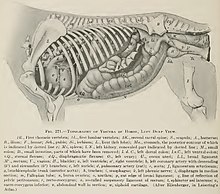
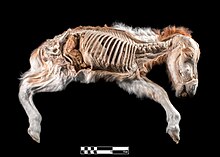
Horses and other equids evolved as grazing animals, adapted to eating small amounts of the same kind of food all day long. In the wild, the horse adapted to eating prairie grasses in semi-arid regions and traveling significant distances each day in order to obtain adequate nutrition.[13] Therefore, the digestive system of a horse is about 30 m (100 ft) long, and most of this is intestines.
Mouth
Digestion begins in the mouth, which is also called the "oral cavity." It is made up of the teeth, the hard palate, the soft palate, the tongue and related muscles, the cheeks and the lips. Horses also have three pairs of salivary glands, the parotoid (largest salivary gland and located near the poll), mandibular (located in the jaw), and sublingual (located under the tongue). Horses select pieces of
Esophagus
The esophagus is about 1.2 to 1.5 m (4 to 5 ft) in length, and carries food to the stomach. A muscular ring, called the cardiac sphincter, connects the stomach to the esophagus. This sphincter is very well developed in horses. This and the oblique angle at which the esophagus connects to the stomach explains why horses cannot vomit.[14] The esophagus is also the area of the digestive tract where horses may suffer from choke.
Stomach

Horses have a relatively small stomach for their size, and this limits the amount of feed a horse can take in at one time. The average sized horse (360 to 540 kg [800 to 1,200 lb]) has a stomach with a capacity of around 19 L (5 US gal), and works best when it contains about 7.6 L (2 US gal). Because the stomach empties when 2⁄3 full, whether stomach enzymes have completed their processing of the food or not, and doing so prevents full digestion and proper utilization of feed, continuous foraging or several small feedings per day are preferable to one or two large ones.[14] The horse stomach consists of a non-glandular proximal region (saccus cecus), divided by a distinct border, the margo plicatus, from the glandular distal stomach.[15]
In the stomach, assorted
Small intestine
The horse's
Large intestine

The large intestine, also known as the hindgut consists of the cecum, large colon, small colon and rectum, terminating in the anus.
Cecum
The cecum (called the "water gut" in old textbooks) is the first section of the large intestine, analagous to the
Large colon
The large colon is 3.0 to 3.7 m (10 to 12 ft) long and holds up to 76 L (20 US gal) of semi-liquid matter. It is made up of the right
Small colon
The small colon is 3.0 to 3.7 m (10 to 12 ft) in length and holds only 19 L (5 US gal) of material. It is the area where the majority of water in the horse's diet is absorbed, and is the place where fecal balls are formed.[14] This section is analagous to the descending colon in humans.
Rectum and anus
The rectum is about 30 cm (1 ft) long, and acts as a holding chamber for waste matter, which is then expelled from the body via the anus.[14]
Reproductive system
Mare
The mare's reproductive system is responsible for controlling gestation, birth, and lactation, as well as her estrous cycle and mating behavior. It lies ventral to the 4th or 5th lumbar vertebrae, although its position within the mare can vary depending on the movement of the intestines and distention of the bladder.
The mare has two ovaries, usually 7 to 8 cm (2.8 to 3.1 in) in length and 3 to 4 cm (1.2 to 1.6 in) thick, that generally tend to decrease in size as the mare ages. In equine ovaries, unlike in humans, the vascular tissue is cortical to follicular tissue, so ovulation can only occur at an ovulation fossa near the infundibulum. The ovaries connect to the fallopian tubes (
Stallion
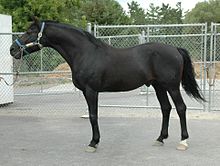
The stallion's reproductive system is responsible for his
Teeth
A horse's teeth include incisors, premolars, molars, and sometimes canine teeth. A horse's incisors, premolars, and molars, once fully developed, continue to erupt throughout its lifetime as the grinding surface is worn down through chewing. Because of this pattern of wear, a rough estimate of a horse's age can be made from an examination of the teeth. Abnormal wear of the teeth, caused by conformational defects, abnormal behaviors, or improper diets, can cause serious health issues and can even result in the death of the horse.
Feet/hooves

The
Skeletal system
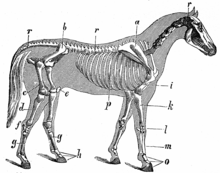
The
- The Appendicular system includes the limbs of the horse;
- The Axial system is composed of the spine, ribs and skull;
The bones of the horse are the same as those of other domestic species, but the third metacarpal and metatarsal are much more developed and the second and fourth are undeveloped, having the first and fifth metacarpal and metatarsal.[22]
| Spine | 54 |
| Ribs | 36 |
| Sternum | 01 |
| Head (including ear ) | 34 |
| Thoracic region | 40 |
| Pelvic region | 40 |
Ligaments and tendons
Ligaments
Ligaments attach bone to bone or bone to tendon, and are vital in stabilizing joints as well as supporting structures. They are made up of fibrous material that is generally quite strong. Due to their relatively poor blood supply, ligament injuries generally take a long time to heal.
Tendons
Tendons are cords of connective tissue attaching muscle to bone, cartilage or other tendons. They are a major contributor to shock absorption, are necessary for support of the horse's body, and translate the force generated by muscles into movement. Tendons are classified as flexors (flex a joint) or extensors (extend a joint). However, some tendons will flex multiple joints while extending another (the flexor tendons of the hind limb, for example, will flex the fetlock, pastern, and coffin joint, but extend the hock joint). In this case, the tendons (and associated muscles) are named for their most distal action (digital flexion).
Tendons form in the embryo from fibroblasts which become more tightly packed as the tendon grows. As tendons develop they lay down
Tendons are easily damaged if placed under too much strain, which can result in a painful, and possibly career-ending, injury.
Muscular system

When a muscle contracts, it pulls a tendon, which acts on the horse's bones to move them. Muscles are commonly arranged in pairs so that they oppose each other (they are "antagonists"), with one flexing the joint (a flexor muscle) and the other extending it (extensor muscle). Therefore, one muscle of the pair must be relaxed in order for the other muscle in the pair to contract and bend the joint properly. A muscle is made up of several muscle bundles, which in turn are made up of muscle fibers. Muscle fibers have myofibrils, which are able to contract due to actin and myosin. A muscle together with its tendon and bony attachments form an extensor or flexor unit.
Respiratory system and smell
The horse's respiratory system consists of the nostrils, pharynx, larynx, trachea, diaphragm, and lungs. Additionally, the nasolacrimal duct and sinuses are connected to the nasal passage. The horse's respiratory system not only allows the animal to breathe, but also is important in the horse's sense of smell (olfactory ability) as well as in communicating. The soft palate blocks off the
Circulatory system
The horse's circulatory system includes the four-chambered heart, averaging 3.9 kg (8.5 lb) in weight, as well as the blood and blood vessels. Its main purpose is to circulate blood throughout the body to deliver oxygen and nutrients to tissues, and to remove waste from these tissues. The hoof (including the frog - the V-shaped part on the bottom of the horses hoof) is a very important part of the circulatory system. As the horse puts weight onto the hoof, the hoof wall is pushed outwards and the frog compressed, driving blood out of the frog, the digital pad, and the laminae of the hoof. When weight is removed from the hoof, the release of pressure pulls blood back down into the foot again. This effectively creates an auxiliary blood-pumping system at the end of each leg. Some of this effect may be lost when a horse is shod (eliminating the expansion and contraction of the hoof wall and raising the frog higher from the ground).[24]
The eye

The horse has one of the largest eyes of all land mammals.[25] Eye size in mammals is significantly correlated to maximum running speed as well as to body size, in accordance with Leuckart's law; animals capable of fast locomotion require large eyes.[26] The eye of the horse is set to the side of its skull, consistent with that of a prey animal.[25] The horse has a wide field of monocular vision, as well as good visual acuity. Horses have two-color, or dichromatic vision, which is somewhat like red-green color blindness in humans.[27] Because the horse's vision is closely tied to behavior, the horse's visual abilities are often taken into account when handling and training the animal.
Hearing

The hearing of horses is good,
See also
- Equine conformation
- Glossary of equestrian terms
- Ergot (horse anatomy)
- Chestnut (horse anatomy)
- Limbs of the horse
References
- ISBN 0851317693.
- ISBN 978-0715318836.
- ^ ISBN 0-7136-1701-2. p.38
- ISBN 0-7216-4102-4
- ^ Interactive points of the horse chart Archived 29 February 2012 at the Wayback Machine
- ^ "OSU Extension Catalog - Oregon State University" (PDF). extension.oregonstate.edu. Archived (PDF) from the original on 11 April 2013. Retrieved 1 May 2018.
- ^ Whittington, Beverly. "Body Parts of the Horse". Gaited Horses. Archived from the original on 30 March 2018. Retrieved 1 May 2018.
- ^ "Skeleton of the horse" (PDF). Archived from the original (PDF) on 29 September 2011. Retrieved 25 August 2011.
- ^ "Parts of the Horse" (PDF). Archived from the original (PDF) on 22 August 2011. Retrieved 25 August 2011.
- ^ "American Quarter Horse". Archived from the original on 29 August 2011. Retrieved 25 August 2011.
- ^ "Points - the Horse". HorseData.co.uk. Archived from the original on 26 September 2011.
- ^ "Definition of THROATLATCH". www.merriam-webster.com. Retrieved 1 May 2018.
- ISBN 0-684-82768-9
- ^ ISBN 0-87605-606-0.
- doi:10.2527/2005.8313_supplE18x. Archived from the originalon 23 February 2013.
- ^ a b c "Horse Nutrition - The Horse's Digestive System." Bulletin 762-00, Ohio State University. Web site accessed 9 February 2007.
- ^ a b c Williams, Carey A. (April 2004). "The Basics of Equine Nutrition". Equine Science Center. Rutgers University. FS #038.
- ISBN 978-3-89993-003-0.
- ISBN 978-1-78064-442-4.
- ISBN 978-1-4160-5234-0.
- ^ "The Stallion: Breeding Soundness Examination & Reproductive Anatomy". University of Wisconsin-Madison. Archived from the original on 16 July 2007. Retrieved 7 July 2007.
- ^ Riegal, Ronald J. DVM, and Susan E. Hakola RN. Illustrated Atlas of Clinical Equine Anatomy and Common Disorders of the Horse Vol. II. Equistar Publication, Limited. Marysville, OH. Copyright 2000.
- ^ Susan J. Holcombe (1998). "Neuromuscular Regulation of the Larynx and Nasopharynx in the Horse" (PDF). Proceedings of the Annual Convention of the AAEP. 44: 26.
- ^ Cook FRCVS PhD, Robert (2008), Shoeing your horse is like foot binding your daughter, Veterinary Times, p. 8, archived from the original (PDF) on 13 August 2017, retrieved 23 August 2011
- ^ ISBN 9781119047742.
- S2CID 26726269.
- ^ McDonnell, Sue. "In Living Color." The Horse, Online edition, 1 June 2007. Web site accessed 27 July 2007 at "The Horse – Your Guide to Equine Health Care". Archived from the original on 27 September 2007. Retrieved 27 July 2007.
- ^ Ensminger, M.E. Horses and Horsemanship, p. 309
- ^ Myers Horse Safe p.7

